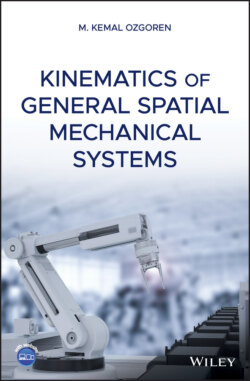Читать книгу Kinematics of General Spatial Mechanical Systems - M. Kemal Ozgoren - Страница 75
3.9.2 Homogeneous, Nonhomogeneous, Linear, Nonlinear, and Affine Relationships
ОглавлениеConsider two column matrices and . Suppose they are related to each other by means of a function so that
(3.168)
Depending on the mathematical features of the function , the relationship described by Eq. (3.168) is characterized by various designations, which are explained below.
1 (a) Homogeneous Versus Nonhomogeneous Relationships
The relationship set up by is called homogeneous if
(3.169)
It is called nonhomogeneous if
(3.170)
1 (b) Linear Versus Nonlinear Relationships
The relationship set up by is called linear if, for a scalar k and for all ,
(3.171)
It is called nonlinear if
(3.172)
In the case of a linear relationship, is expressed as follows in terms of an m × n matrix , which does not depend on :
(3.173)
Note that a linear relationship is also homogeneous, but a nonlinear relationship may or may not be homogeneous.
1 (c) Affine Relationship
The relationship set up by is called affine, if is expressed as follows in terms of an m × n matrix and an m × 1 matrix , which are both independent of .
(3.174)
In Eq. (3.174), is defined as the bias term. It may or may not be zero, i.e. .
Note that a general affine relationship with is both nonhomogeneous and nonlinear. However, a special affine relationship with happens to be both homogeneous and linear.
